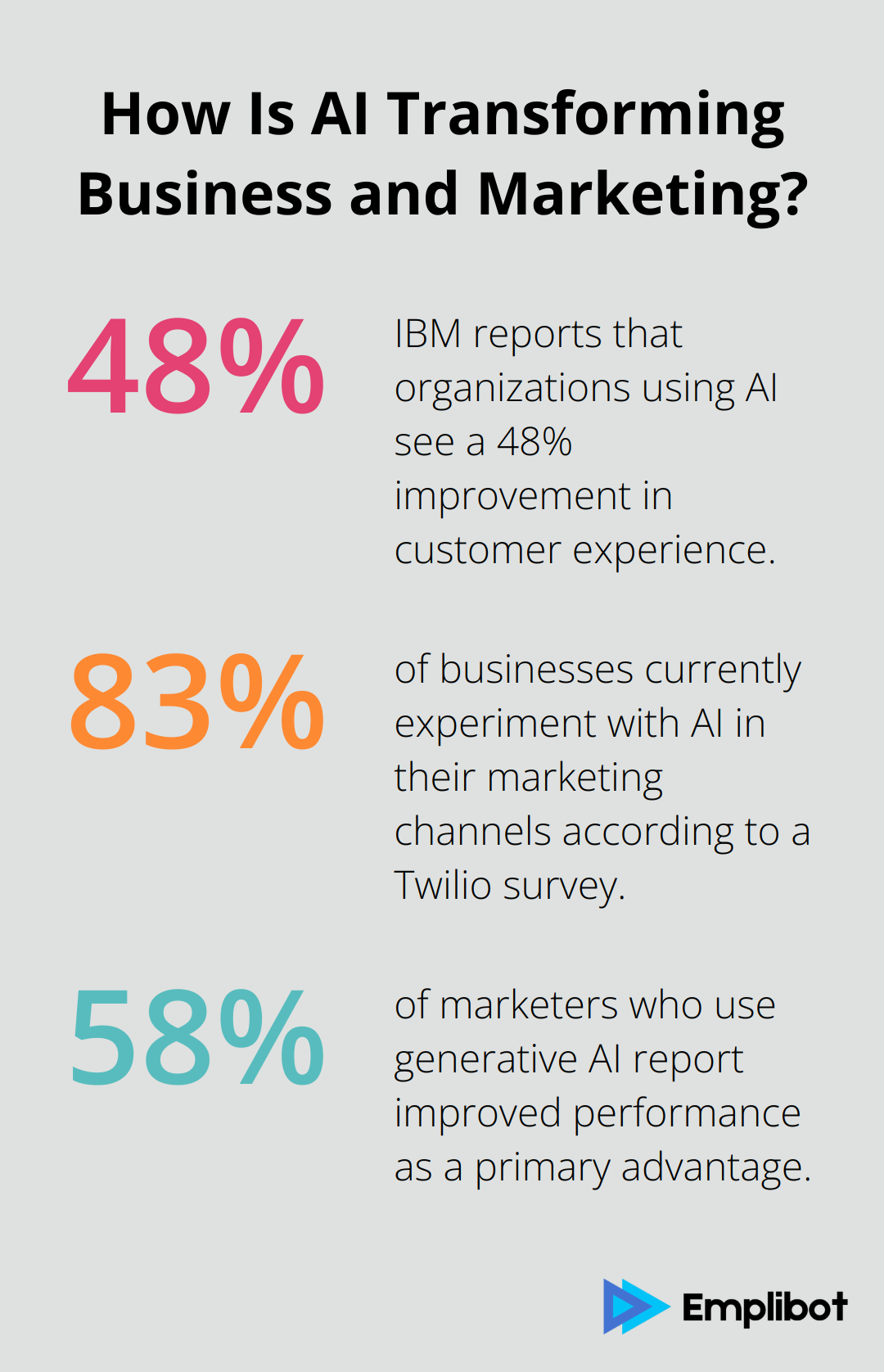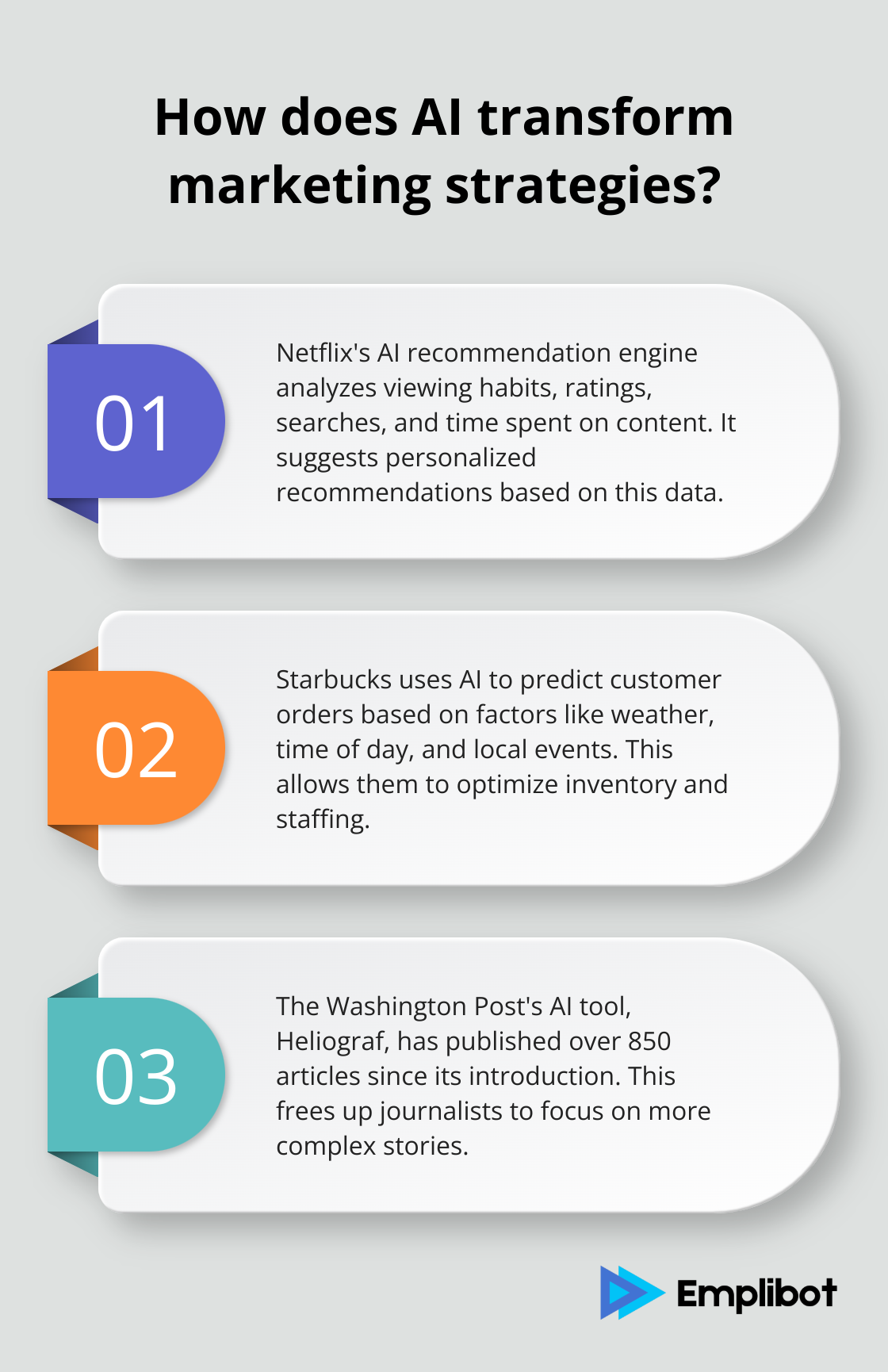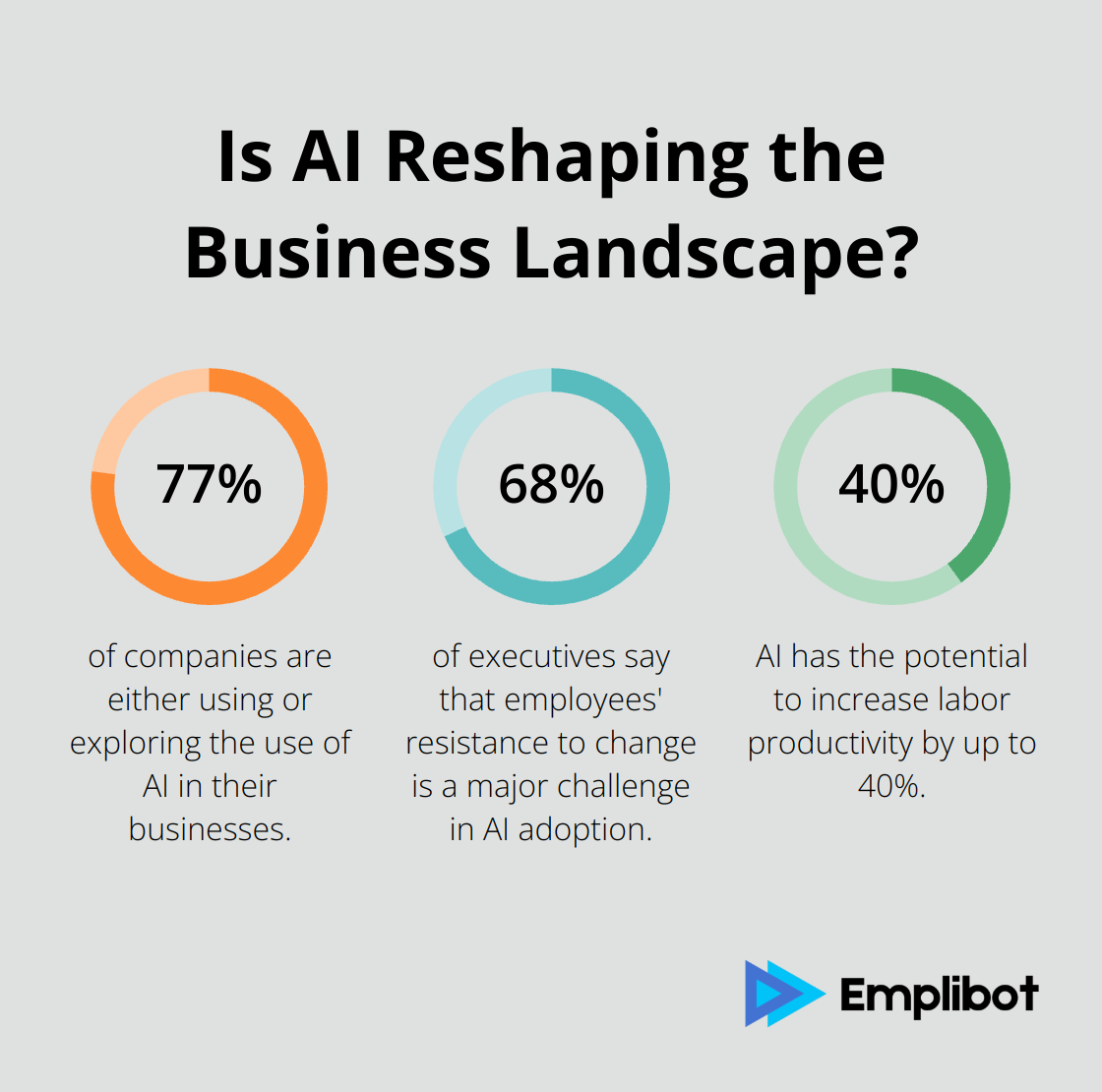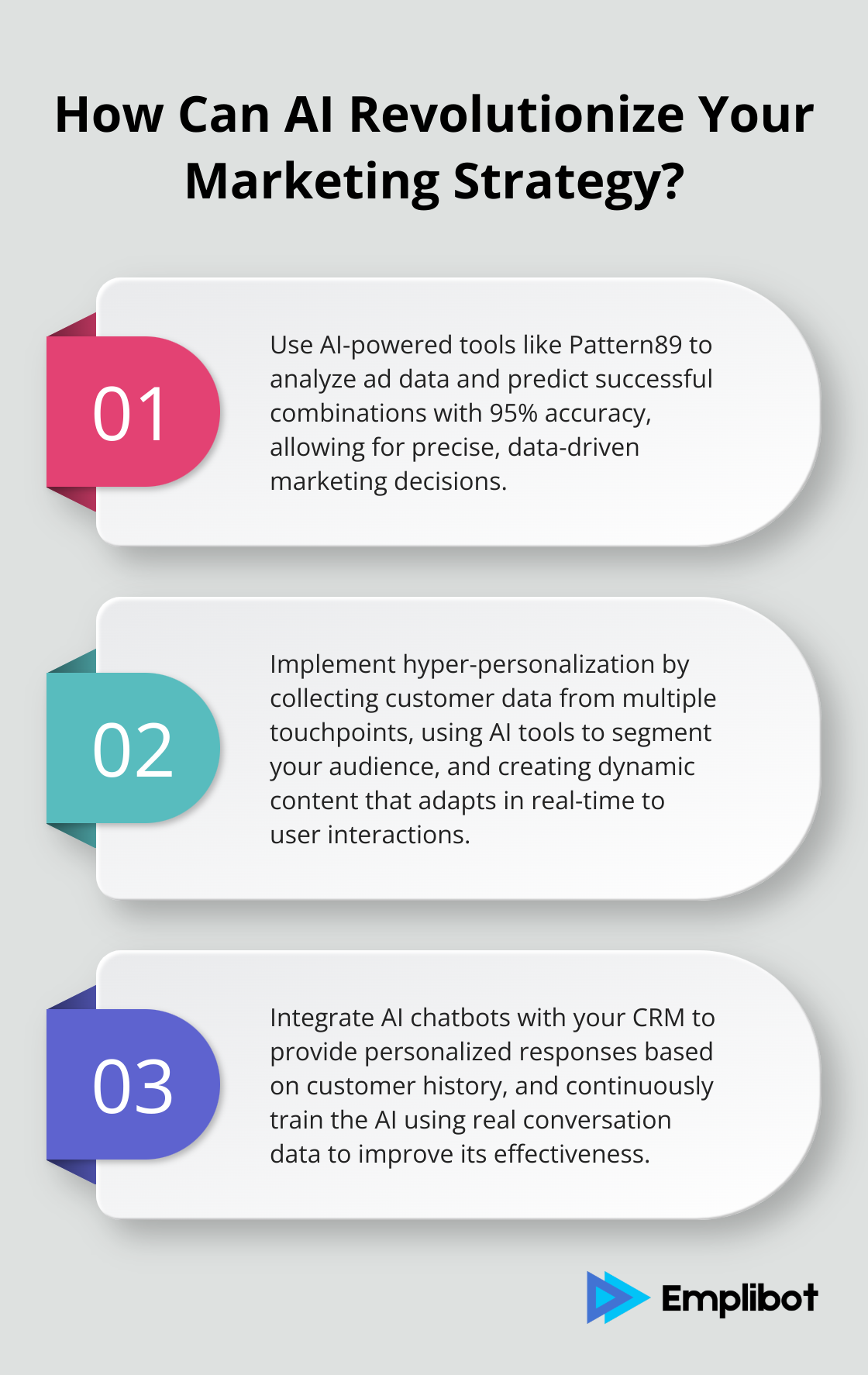At Emplibot, we’ve seen AI revolutionize marketing strategies across industries. The question on everyone’s mind is: How to use AI for marketing effectively?
AI-powered tools are transforming how businesses connect with customers, analyze data, and create content. In this post, we’ll explore practical ways to leverage AI for your marketing efforts, backed by real-world examples and actionable tips.
What is AI in Marketing?
Defining AI in Marketing
AI in marketing represents a revolutionary approach to automating and optimizing marketing processes. It employs machine learning algorithms and data analysis to transform how businesses interact with their audience. From intelligent chatbots handling customer inquiries to sophisticated predictive analytics forecasting consumer behavior, AI reshapes the marketing landscape.
The Current State of AI Adoption
The marketing world embraces AI at an unprecedented rate. A recent Twilio survey reveals that 83% of businesses currently experiment with AI in their marketing channels. This rapid adoption stems from the concrete benefits AI offers. For instance, 58% of marketers who use generative AI report improved performance as a primary advantage.
Types of AI Revolutionizing Marketing
Several AI technologies make significant impacts in marketing:
- Natural Language Processing (NLP): Powers chatbots and content creation tools.
- Machine Learning Algorithms: Drive personalization and predictive analytics.
- Computer Vision: Revolutionizes image and video analysis for brand monitoring and competitor tracking.
Measurable Benefits of AI-Powered Marketing
AI in marketing delivers substantial, quantifiable benefits. Personalization, a key AI advantage, significantly enhances customer engagement. For example, emails with personalized subject lines are 26% more likely to be opened compared to generic ones.

AI also amplifies data analysis capabilities. Tools like Pattern89 analyze over 350 billion data points to predict successful ad combinations with 95% accuracy (an impressive feat that allows marketers to make precise, data-driven decisions).
Real-World Applications of AI in Marketing
AI finds practical applications across various marketing functions:
- Personalized Recommendations: Amazon’s AI-driven recommendation engine suggests products based on individual browsing history, past purchases, and items frequently bought together.
- Ad Optimization: Google Ads and Facebook utilize AI for dynamic ad targeting and automated bidding, helping businesses optimize their ad spend.
- Content Creation: AI tools (such as ChatGPT and Jasper) assist marketers in idea generation and efficient copy creation.
- Visual Content: Canva’s AI-generated images transform social media content creation.
- Customer Experience: IBM reports that organizations using AI see a 48% improvement in customer experience, directly translating to enhanced satisfaction and loyalty.
As we move forward, it’s essential to understand how to implement these AI-driven strategies effectively in your marketing efforts. The next section will guide you through the process of integrating AI into your existing marketing framework, ensuring you harness its full potential.
AI-Driven Marketing Strategies That Work
Hyper-Personalization at Scale
AI now enables hyper-personalization at a previously unimaginable scale. Netflix’s AI recommendation engine analyzes massive amounts of data, including viewing habits, ratings, searches, and time spent on content to suggest personalized recommendations.

To implement hyper-personalization in your marketing:
- Collect and analyze customer data from multiple touchpoints.
- Use AI tools to segment your audience based on behavior, preferences, and demographics.
- Create dynamic content that adapts in real-time to user interactions.
Predictive Analytics for Smarter Decisions
Predictive analytics transforms how marketers forecast trends and make decisions. Starbucks uses AI to predict customer orders based on factors like weather, time of day, and local events (allowing them to optimize inventory and staffing).
To leverage predictive analytics:
- Identify key performance indicators (KPIs) that align with your business goals.
- Implement AI-powered analytics tools that can process large datasets.
- Use insights to inform product development, pricing strategies, and marketing campaigns.
AI-Powered Content Creation and Curation
AI revolutionizes the entire content creation process. The Washington Post’s AI tool, Heliograf, has published over 850 articles since its introduction (freeing up journalists to focus on more complex stories).
To harness AI for content:
- Use AI writing tools for generating ideas, headlines, and first drafts.
- Employ AI-powered content curation tools to find and share relevant industry news.
- Utilize AI for A/B testing headlines and content variations to maximize engagement.
Human oversight remains essential for maintaining brand voice and ensuring quality.
Conversational AI and Chatbots
Conversational AI transforms customer interactions. H&M has successfully personalized the shopping experience for customers by leveraging AI technology, resulting in increased engagement.
To implement conversational AI effectively:
- Identify common customer queries and pain points.
- Design conversation flows that feel natural and align with your brand voice.
- Continuously train your AI using real conversation data to improve responses.
- Integrate your chatbot with your CRM to provide personalized responses based on customer history.
These AI-driven strategies offer immense potential, but their implementation requires careful consideration. The next section will guide you through the process of effectively integrating these AI tools into your existing marketing framework, ensuring you harness their full potential while addressing your specific business needs.
How to Implement AI in Your Marketing Strategy
Assess Your Current Marketing Landscape
Start with a thorough audit of your existing marketing processes. Identify areas where AI could streamline operations or enhance performance. For example, if your email open rates are low, AI-powered subject line optimization might be a good starting point. AI technology can adapt to user engagement and feedback over time, continuously optimizing subject lines to improve open rates and overall email engagement. If customer service is overwhelmed, a chatbot could be the solution.

Set clear, measurable goals for your AI implementation. These could range from increasing conversion rates by a specific percentage to reducing customer service response times. According to research, 77% of companies are either using or exploring the use of AI in their businesses. Be specific and realistic in your goal-setting to ensure you can accurately measure the impact of AI on your marketing efforts.
Select the Right AI Tools
Research AI tools that align with your objectives. The market offers many options, so focus on those with proven track records in your industry. For example, if you’re in e-commerce, look into AI-powered recommendation engines like those used by Amazon (which have been shown to drive up to 35% of their revenue).
When evaluating tools, consider factors like ease of integration, scalability, and customer support. Don’t just opt for the most advanced or expensive option – choose tools that fit your current needs but also have room for growth as your AI capabilities expand.
Integrate AI with Your Existing Tech Stack
Successful AI implementation requires seamless integration with your current marketing technologies. This process can be complex, so it’s important to have a clear integration plan. Start by ensuring your data is clean and accessible – AI is only as good as the data it’s fed.
If you use a CRM system, look for AI tools that can directly integrate with it. This allows for more personalized customer interactions and more accurate predictive analytics. For instance, Salesforce Einstein AI integrates directly with their CRM, providing insights that have led to an average 38% increase in lead conversion rates for users.
Upskill Your Team
Your team is your most valuable asset in this transition. Invest in comprehensive training to ensure they understand not just how to use the new AI tools, but also the strategic thinking behind them. A survey by Deloitte found that 68% of executives say that employees’ resistance to change is a major challenge in AI adoption.
Create a culture of continuous learning. Encourage team members to experiment with AI tools and share their findings. Consider appointing AI champions within your team who can help others and drive adoption.
AI is not about replacing your team, but augmenting their capabilities. A study by Accenture found that AI has the potential to increase labor productivity by up to 40%. The combination of human creativity with AI’s analytical power can achieve marketing results that were previously unattainable.
Monitor and Refine Your AI Strategy
Implementing AI in your marketing efforts is an ongoing process of refinement and optimization. Start small, measure results, and scale up as you see success. Regularly review the performance of your AI tools against your set goals. Use these insights to make data-driven decisions about which AI strategies to expand and which to adjust.
Final Thoughts
AI revolutionizes marketing strategies across industries, enabling marketers to connect with customers more effectively and analyze data efficiently. The future of AI in marketing promises even more sophisticated applications, including advancements in voice search optimization and AI-driven customer journey mapping. To start using AI for marketing, assess your current landscape, select tools that align with your needs, and integrate them with your existing tech stack.

AI augments human creativity in marketing, combining analytical power with human insight for successful strategies. Emplibot understands this transformative power and automates content marketing efforts, handling everything from keyword research to content creation and distribution. Our platform helps businesses increase traffic, leads, and sales while saving time and resources.
The most effective marketing strategies will blend AI capabilities with human innovation. AI adoption positions businesses for success in the evolving digital landscape. As you implement AI in your marketing efforts, start small, measure results, and scale up based on positive outcomes.

